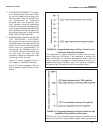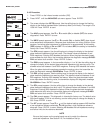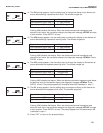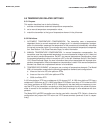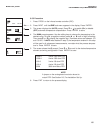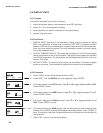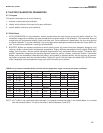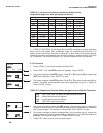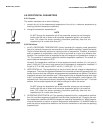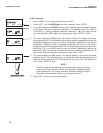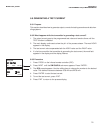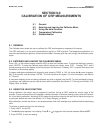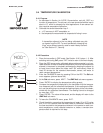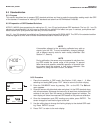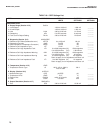
69
MODEL 3081 pH/ORP SECTION 8.0
PROGRAMMING FOR pH MEASUREMENTS
8.8 ISOPOTENTIAL PARAMETERS
8.8.1 Purpose
This section describes how to do the following:
1. convert the pH at the measurement temperature to the pH at a reference temperature by
entering a solution temperature coefficient,
2. change the transmitter isopotential pH.
NOTE
Do NOT change the isopotential pH of the transmitter unless you are thoroughly
familiar with the role of sensor and transmitter isopotential points in pH measure-
ment, OR unless the sensor operating instructions specifically state that the
isopotential pH is a value other than pH 7.
8.8.2 Definitions
1. pH AT A REFERENCE TEMPERATURE. Certain industries (for example, power generation)
use pH to indirectly measure the concentration of dilute alkaline solutions, typically ammonia.
The pH of dilute ammonia solutions is a strong function of temperature. Therefore, to make pH
solely a measure of concentration, the pH must be converted to a value at a reference tem-
perature. The correction factor is expressed as the pH change per unit temperature change (in
°C). The correction is commonly called the solution temperature coefficient. The almost uni-
versal reference temperature is 25°C.
Example: The temperature coefficient of dilute aqueous ammonia solutions (0.1 to 5 ppm) is
about -0.032 pH/°C (the minus sign means the pH decreases as temperature increases). If
the pH at 31°C is 8.96, the pH at 25°C is 8.96 + (-0.032) (25 - 31) = 9.15.
2. ISOPOTENTIAL pH. The isopotential pH is the pH at which the cell voltage is independent of
temperature. The closer the agreement between the transmitter and sensor isopotential pH, the
smaller the error when the calibration and measurement temperatures are different. The default
isopotential value for the transmitter is pH 7. Most sensors have an isopotential point fairly close
to pH 7, so the default value rarely needs changing. For more information, consult Section 13.8,
Isopotential pH. Some sensors have an isopotential pH distinctly different from pH 7. For these
sensors, the transmitter isopotential pH must be changed to match the sensor.
NOTE
Do NOT change the isopotential pH of the transmitter unless you are thoroughly
familiar with the role of sensor and transmitter isopotential points in pH measure-
ment, OR unless the sensor operating instructions specifically state that the
isopotential pH is a value other than pH 7.
3. OPERATING ISOPOTENTIAL pH. The operating isopotential pH is a mathematical combina-
tion of the solution temperature coefficient and the meter isopotential pH. Changing the solu-
tion temperature coefficient ALWAYS changes the operating isopotential pH. When program-
ming the transmitter to perform a solution temperature compensation, it is ALWAYS better to
enter the solution temperature coefficient and allow the transmitter to calculate the operating
isopotential pH.



